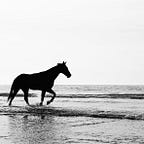The Amazing Story Of The World’s First Ever Photograph
Photography is a universal language that uses light to capture fixed images of the world. Despite its near ubiquity in today’s culture, it’s often forgotten that the art of photography is relatively new, with a short history that only began in the early 19th century as the result of one determined man.
The First Permanent Photograph
The earliest pioneer of modern photography was Joseph Nicephore Niepce. He captured the first permanent photographic image from his window in Saint-Loup-de-Varennes, France, in 1827; which he titled, simply, ‘View from the Window in Le Gras’.
Sun Writing & The Dawn Of Photography
Niepce called his revolutionary technique heliography, or ‘sun writing’, which as a concept is more beautiful, and certainly esoteric, than the image itself! Nonetheless, the first permanent image had been captured and photography was born.
The process of inventing this unique technique, which began the photographic era, took well over a decade of dedicated work to perfect. As Neipce said :
I used some of the time while here in making a kind of artificial eye, which is nothing but a small box six inches square; the box will be equipped with a tube that can be lengthened and will carry a lenticular glass. This apparatus is necessary in order to properly complete my process. (1814)
Following the development of his ‘artificial eye’ Niepce could still see that the process was far from over, as he explains, several years later :
I must now do three things: (1) give more sharpness to the representation of the subject; (2) transpose the colors; and (3) fix them permanently, which will not be the easiest of the three. (1816)
This final piece of the puzzle, finding a way to permanently fix the image, had eluded the great inventors of history and was a huge challenge for Niepce to overcome. The odds must certainly have seemed stacked against the inventor as he pondered the problem in his lonely studio in rural France.
After more than a decade of work in near isolation, Niepce solved the mystery and you can almost hear the relief in his words as he describes the discovery :
The discovery I have made and which I call Heliography, consists in reproducing spontaneously, by the action of light, with gradations of tints from black to white, the images received in the camera obscura.
Niepce’s Photo Is Lost And Found
Following Niepce’s discovery, his photograph was exhibited all over the world. However, the photograph was soon lost to the pages of history sometime after its last known exhibition in 1905. For almost 50 years nobody knew where it had gone, until…
In 1952, a husband and wife team of historians, Helmut and Alison Gernsheim, after years of searching, found the photograph in a trunk of an undisclosed location. With the help of a close friend, Sir Francis Bauer, they arranged to have the prestigious Kodak Research Lab test it for authenticity. The results came back positive and it wasn’t long before the near-mythic photo was back on tour again.
After touring the world for 10 years, the photo was bought by Harry Ransom in 1962. The philanthropist placed the priceless photo in the central lobby of the Harry Ransom Center, a museum, archive and library at the University of Texas, where it remains to this day.
Sun Writing — The Birth Of A New Era
The ‘View from the Window in Le Gras’ is a grainy, haunting and out-of-focus image that made a humble beginning for an artform that would forever transform society.
Few discoveries have had a more profound influence on the past 200 years of human history, and despite being lost and found, the first ever permanent photograph remains a testament to the unrelenting determination of Joseph Nicephore Niepce.
